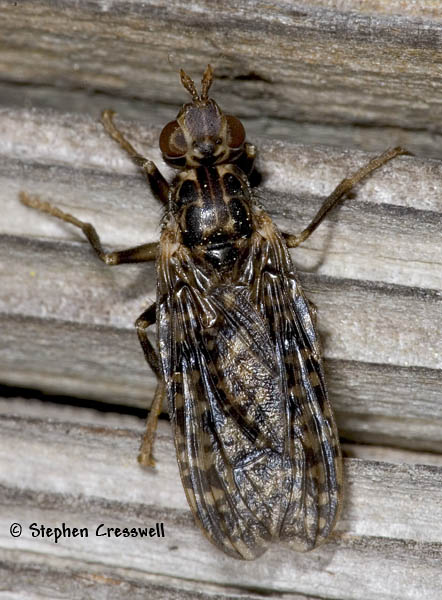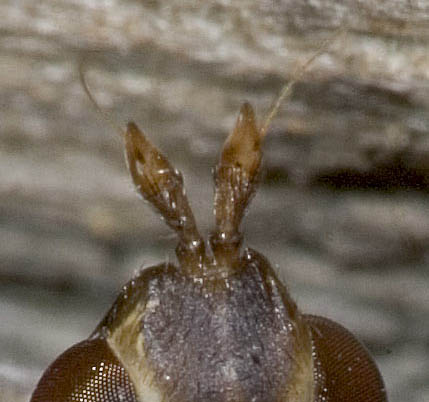Diptera.info :: Identification queries :: Diptera (adults)
|
Unusual Fly at Lights from Mississippi USA
|
|
| Stephen |
Posted on 22-04-2006 13:07
|
|
Member Location: West Virginia USA Posts: 1322 Joined: 12.04.05 |
This handsome fly showed up at my mercury vapor lamp. I liked the markings both on the anterior end and on the wings too. Can anyone tell me what I have here? Location: Mississippi, USA Date: 16 April 2006 Stephen attached the following image:  [89.32Kb] --Stephen Stephen Cresswell www.americaninsects.net |
| totipotent |
Posted on 22-04-2006 15:25
|
|
Member Location: Texas A&M University, USA Posts: 21 Joined: 10.02.06 |
Stephen, The antennae on this wonderful specimen tells me it is a Tabanid, but the wings are throwing me off. ------------------------------------------------------------------------------------- |
| Nikita Vikhrev |
Posted on 22-04-2006 15:50
|
|
Member Location: Moscow, Russia Posts: 9512 Joined: 24.05.05 |
My impression was Sciomyzidae. Well, let's wait for experts. Nikita Nikita Vikhrev - Zool Museum of Moscow University |
|
|
|
| totipotent |
Posted on 22-04-2006 16:02
|
|
Member Location: Texas A&M University, USA Posts: 21 Joined: 10.02.06 |
Nikita Vikhrev wrote: My impression was Sciomyzidae. Well, let's wait for experts. Nikita I do admit that the head and wings look more like it belongs to Sciomyzidae, but there are no arista on these antennae...? ------------------------------------------------------------------------------------- Edited by totipotent on 22-04-2006 19:27 |
| conopid |
Posted on 22-04-2006 19:09
|
|
Member Location: United Kingdom Posts: 1039 Joined: 02.07.04 |
I'll vote for Scyomizidae. It certainly does not look like any kind of Tabanid we get in the UK. Whatever it is, it's a very nice beast!
Nigel Jones, Shrewsbury, United Kingdom |
|
|
|
| Xespok |
Posted on 23-04-2006 15:29
|
|
Member Location: Debrecen, Hungary Posts: 5551 Joined: 02.03.05 |
This fly also reminds me some Platystomatidae flies. The lack of arista on the picture is possibly an angle artefact. They likely point upwards and are thus invisible from this angle. Actually giving a second look, the aristae might be there, but are not visible properly. Edited by Xespok on 23-04-2006 15:30 |
| Stephen |
Posted on 23-04-2006 19:03
|
|
Member Location: West Virginia USA Posts: 1322 Joined: 12.04.05 |
By cropping, I came up with this closer view of the antennae. Thanks to one and all for the comments so far.
Stephen attached the following image:  [48.57Kb] --Stephen Stephen Cresswell www.americaninsects.net |
| Kahis |
Posted on 23-04-2006 20:07
|
|
Member Location: Helsinki, Finland Posts: 1999 Joined: 02.09.04 |
Sciomyzidae. The arista is white and poorly visible in the small version but easily seen in the cropped version. Sciomyzidae is a relatively small family with ~600 species worldwide. Still, I am not able to give you a name or even a genus. Sciomyzids are amon the few groups of flies that often apper on light. Given that their larval hosts are mostly nocturnal I suspect that the adult sciomyzids do seek their victims at night. Some, like Anticheta, are easy to find with light traps but seldom seen in netted samples. Kahis |
| Nikita Vikhrev |
Posted on 03-11-2006 00:16
|
|
Member Location: Moscow, Russia Posts: 9512 Joined: 24.05.05 |
It seems to me that there aren't oc setas. Is there another genus without oc exept Sepedon?
Nikita Vikhrev - Zool Museum of Moscow University |
|
|
|
| Dmitry Gavryushin |
Posted on 03-11-2006 08:55
|
|
Member Location: Moscow region, Russia Posts: 3345 Joined: 17.10.05 |
Yes there are two that I know of: Sepedomerus (postocellar bristle absent) and Hedria (postocellar bristle well-developed, 2 fronto-orbital bristles, posterior crossvein bisinuate) (The Marsh Flies of California, by Fisher and Ort, 1983) |
|
|
|
| Nikita Vikhrev |
Posted on 03-11-2006 10:40
|
|
Member Location: Moscow, Russia Posts: 9512 Joined: 24.05.05 |
Thank you Dima. Sepedon always has elongated 2-nd antennal segment, so it isn't Sepedon. In web there is one image of Sepedomerus. If photo ID is correct it isn't Sepedomerus. More probable candidate - Hedria mixta. There is one image in: http://www.entomology.umn.edu/museum/links/Interactive%20Key%20Gallery/source/sciomyzid(hedria).htm I'm sure Stephen will check it using US sources. Nikta Nikita Vikhrev - Zool Museum of Moscow University |
|
|
|
| Tony Irwin |
Posted on 03-11-2006 19:12
|
|
Member Location: Norwich, England Posts: 7327 Joined: 19.11.04 |
But the second antennal segment is elongated (longer than the third in the enlargement). Also Hedria has an s-shaped cross-vein. This fly has a straight cross-vein. My money is on Sepedon.
Tony ---------- Tony Irwin |
|
|
|
| Nikita Vikhrev |
Posted on 03-11-2006 19:17
|
|
Member Location: Moscow, Russia Posts: 9512 Joined: 24.05.05 |
You made a wise stake Sepedon - 70 speciec, Hedria - 1. Sepedon - 70 speciec, Hedria - 1. Let's wait what Stephen find, I think with this wings the answer will be species level. Nikita Nikita Vikhrev - Zool Museum of Moscow University |
|
|
|
| Gerard Pennards |
Posted on 03-11-2006 21:47
|
|
Member Location: Amersfoort Posts: 1914 Joined: 07.06.04 |
Well, I don't want to spoil the party, but if i remember well this fly is on the bugguide.net site as in the family Pyrgotidae! Greetings, Gerard Greetings, Gerard Pennards |
|
|
|
| Stephen |
Posted on 04-11-2006 15:10
|
|
Member Location: West Virginia USA Posts: 1322 Joined: 12.04.05 |
Sorry, I was away for a day only to discover my photo I posted here in April was being discussed again. Last July I posted this same photo on BugGuide, after having discovered a similar-looking fly photo also on BugGuide. That photo had been identified as Pyrgotidae by the Curator of Diptera at the Florida State Collection of Arthropods. Here are the two photos; only the first one has any discussion with it: http://bugguide.net/node/view/15878 http://bugguide.net/node/view/63605 I should have come back here and updated this post, but I supposed it was long-forgotten, buried on page 80 of the forum. Please accept my apologies! Edited by Stephen on 04-11-2006 20:18 --Stephen Stephen Cresswell www.americaninsects.net |
| Nikita Vikhrev |
Posted on 04-11-2006 15:47
|
|
Member Location: Moscow, Russia Posts: 9512 Joined: 24.05.05 |
Tony, all our stakes gone to Gerard! Stephen, we havn't yet this family in the Gallery, do your best to ID! Nikita Nikita Vikhrev - Zool Museum of Moscow University |
|
|
|
| Stephen |
Posted on 04-11-2006 17:09
|
|
Member Location: West Virginia USA Posts: 1322 Joined: 12.04.05 |
Nikita, I do have one identified Pyrgotid photo and I will pass it on to Paul shortly for the gallery. Xespok has one photo of a Pyrogotid in the gallery already. From what I can tell, the photo at the top of this page is either Pyrgota maculipennis or Sphecomyiella valida, two species which, although in different genera, are supposed to be hard to tell apart. I wrote to the curator gentleman who made the ID on BugGuide to see if he would look at my photo, but I did not hear back from him. Here are his comments about the photo at BugGuide that looked very similar to mine: "Pyrgota maculipennis. The wing and body patterns of P. maculipennis cannot be distinguished easily from those of Sphecomyiella valida, but the 11 mm length, body proportions, and especially the shape and banded color pattern of the hind tibia give me confidence in this identification. Sphecomyiella valida is usually at least a few mm longer, stouter of body, and with a gradually expanding hind tibia that is not distinctly banded. Pyrgota maculipennis has also gone under the genus names Sphecomyiella and Boreothrinax." For the record, if I took my photo (at the top of this page) at my lens' closest focus, and I think I did, then the fly was 12.3 mm long. On a completely different subject, I notice there is not a single Chironomid photo in the gallery. I guess the problem is not that we don't have photos, but that none of them are identified? Still, it seems like even an unidentified Chironomid would be better than none at all, for any visitor who wondered what a Midge looks like. Edited by Stephen on 04-11-2006 17:22 --Stephen Stephen Cresswell www.americaninsects.net |
| Tony Irwin |
Posted on 04-11-2006 18:28
|
|
Member Location: Norwich, England Posts: 7327 Joined: 19.11.04 |
Ooops! Thanks to Gerard for preventing any further embarassment!  Reading up on this family, it looks like this is Sphecomyiella valida. It's certainly not the same species as that identified as Pyrgota (formerly Boreothrinax) maculipennis, which has a completely different hind tibia shape. Astonishing life history - oviposition in scarabeid hosts while in flight (at night), and larva completes its development in two weeks. 
Tony ---------- Tony Irwin |
|
|
|
| Nikita Vikhrev |
Posted on 04-11-2006 20:20
|
|
Member Location: Moscow, Russia Posts: 9512 Joined: 24.05.05 |
Stephen: On a completely different subject, I notice there is not a single Chironomid photo in the gallery. I guess the problem is not that we don't have photos, but that none of them are identified? Still, it seems like even an unidentified Chironomid would be better than none at all, for any visitor who wondered what a Midge looks like. My oppinion is that we can load in several cases images of Diptera ID only till genus or even family. But temporary. When somebody will load, for example, fly with full ID, previos images have to be deleted. Same situation with images of not the best quality. For example, I'd prefer to delet some of my early images and replace it by new better images. Nikita Nikita Vikhrev - Zool Museum of Moscow University |
|
|
|
| Jump to Forum: |













